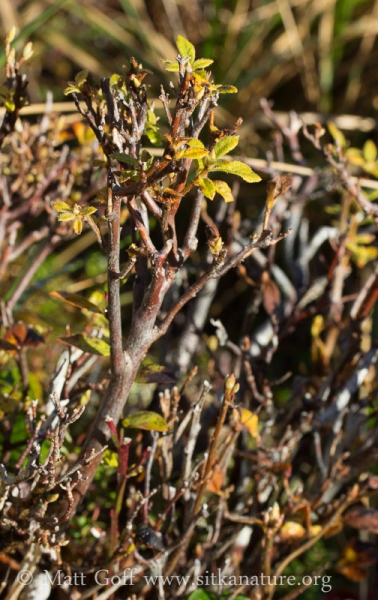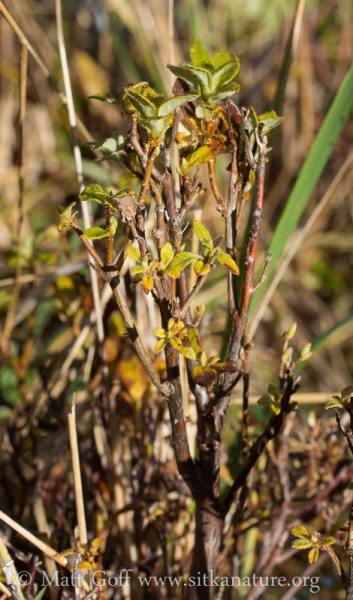One of the things that stood out to me on my recent visit to Ataku Island was how heavily some of the false azalea (Menziesia ferruginea) was browsed. The first stop we made after leaving the beach was a small clearing at the top of a knoll. It was not entirely evident to me why this area was not treed, as it would seem to have reasonable drainage (being at the top, without a lot of flat area to collect water) and nothing topography or underlying soil/bedrock-wise to keep the trees from growing. Although it had some species of muskegs, including Labrador tea (Rhodendron groenlandicum, both species of cranberries as well as the dwarf shrub blueberries (Vaccinium spp.), and crowberry (Empetrum nigrum), there was not sphagnum that I could find, and there was a fair amount of grass (but I think maybe not sedges, although I could be wrong, as I didn’t check closely) growing in the mix. Also present were the rusty menziesia (Menziesia ferruginea) shown in the pictures here.
Rusty menziesia is generally considered unpalatable for deer, and I think I’ve only rarely noticed it browsed on, and then typically only a small amount. What stood out about these was how far down the stems had been browsed, apparently repeatedly over multiple years, given the size of the main stem. At least that was my impression. Following a pattern I’ve seen elsewhere with other browse, it was interesting to note that not 20 feet away was a larger menziesia plant that showed very little sign of being browsed. Also of interest to me was the conspicuous lack of evidence that the Labrador tea had been browsed at all, there were many robust shrubs growing on (or maybe helping to create) small hummocks in the clearing.
Ataku Island is not large, though it is connected at low tide to the somewhat larger Tava Island. Deer are good swimmers and these islands would not require an especially long swim to leave (or reach). That said, deer on the island might prefer to stay when the temperatures drop. There was plenty of reasonably fresh deer sign in the form of pellet piles in the clearing. I don’t know how many deer that represented, but it seemed clear at least one liked to hang out there.
I suspect the clearing is favored resting spot of deer. Perhaps they liked being up at a high spot so it could hear the approach of others (sound seems to carry better uphill), but also the relative protection of this spot, as the trees were tall enough to provide a wind break. The heaviness of the browse in the clearing proper combined with the almost non-existent browse not far away makes me think maybe the deer is just lying there munching on what it can reach, even if it’s not particularly palatable. If it goes through the effort of actually moving at all, it will move to where there is better food than the menziesia.
I also wonder if the clearing is being maintained by deer. There were a few very small evergreens growing. They did not seem obviously browsed to me, but I am not sure if maybe at times (especially in winter) they get hit. Although I did not explore the island thoroughly, some of what I did see didn’t look especially nice as far as deer forage is concerned. There were extensive patches of what look like older second growth (perhaps cut down during WWII) where there was plenty of moss, but very little understory herbaceous or shrubby plants. Of course other areas were more open with some graminoids and shrubs. Unfortunately I did not pay enough attention to note the amount of browse evidence I saw in those areas.
Questions:
- How many deer spend time on Ataku Island?
- How long do deer typically stay on the island?
- Assuming there is a seasonal pattern to deer inhabiting the island, what season is preferred?
- Are deer maintaining the clearing? If not, then what?


Good questions, Matt. I noticed some browse on Ataku this spring on the S side, and thought it was a little unusual. When I started paying attention, I saw a little more browsed Menzesia on small islands with a number of deer. My working theory—and I’m likely wrong—is that sometimes there’s not much else available, and maybe the Menzesia feels better than nothing else in deep snow. That would makes sense on the South side cliffs, where perhaps the sun melts the snow first.
Theory#2 Nels mentioned in one of his programs that watching deer browse seaweed in Winter that they’re highly selective (despite that fact that seaweed also is reported to have little to no nutritive value.) Nels theorized that perhaps the deer were able to sense to seaweed with more nutritive value. Makes sense when my boys feed their pets rats, and they prefer organic foods.
Could that particular Menzesia you saw be tastier with more nutritive value? Or perhaps that knoll is more protected from snow from trees above? I know that I don’t much, but sure have a lot of guesses & theories!
Thanks Zach – I lost track of this comment for a while, but still wanted to respond (even though it’s been over a year). I appreciate you taking the time to share some theories you have. They sound plausible to me, but I don’t know how we could easily test them! It sounds like it might have something to do with small islands – though deer seem to be able to move easily enough between them. This brings up another question – how often do deer on these small islands tend to move between them? I wonder if there are deer that pretty much stick to one or two small islands for their whole life…